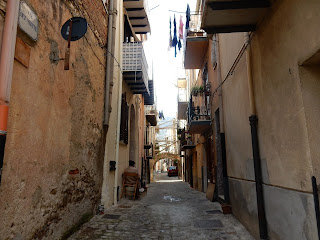It's All About The Manna...
il 17 aprile
Palermo
This morning was an excursion to Castelbuono and Cefalù, two towns on the northern coast. The former boasts a medieval castle, founded by Francesco I Ventimiglia and built in 1316, whose initial function was to defend the town. In 1454 it became the seat of the marquis, and by 1500, the castle was turned into a residence of great prestige. The Ventimiglia family commissioned the creation of stuccos in its new Palantine Chapel in 1684, but,with the ensuing centuries, the family's importance declined, as well as the condition of the castle. Earthquakes destroyed much of the structure in 1818 and 1819; however, in 1920 the municipality raised funds and is now in control of this impressive landmark. In addition to the castle, of great human interest to many of us was the system of trash pick-up; as the town does not accommodate cars on its narrow cobbled streets, the only way this can be done is by donkey. The citizens of Castelbuono attach their bags of garbage to hooks outside their doors and a donkey comes by (led by someone, of course) and picks them up..ingenious, practical, and harking back to days of old.
Our next stop was Cefalù, a lovely seaside town, where we viewed the cathedral whose building began in 1131, about 40 years after the Normans conquered Sicily. There is a story that tells of Roger II, the King of Sicily, making a holy vow after escaping a storm and landing on the town's beach. The building is fortress-like, rising high above the town, and certainly made a strong statement of the Norman presence.
Having some time before lunch, I wandered around and discovered a °music club° where the locals go to play music and enjoy °la dolce vita.° I, naturally, had to go in and stay awhile. A few of my travel buddies joined me and Davide and I danced a bit and had a merry time. This is why I love to travel...to appreciate whatever comes my way and immerse myself in the culture of wherever I am.
One of Cefalù's °claims to fame° is manna, a natural sweetener found only in the area. Intensive cultivation of manna, which began in earnest in the 17th century, is a time-consuming process whereby a transparent resin is extracted by making incisions in a particular type of ash tree. The resin then becomes dense and crystallizes in sweet white stalactites when it comes in contact with the summer air.Many of us sampled and purchased bags of it (tastes great as candy and is also helpful for digestion), but it wasn't until we stopped at a bakery after lunch that I discovered its true gift...la crema alla manna...a soft, sweet, spreadable cream that goes wonderfully well on anything, but, especially on the panettone made at the bakery. Now, this was not like any packaged panettone found in the markets at XMAS, but a delectable, sweet cake that I could not seem to sample enough of! Naturally, I purchased a fresh panettone and a jar of crema alla manna and carried them both all through Sicily. I didn't know at the time that after barely a week in Assisi, the panettone would be gone and my jar of manna cream nearly finished...alas, if I had only bought more...
















What a beautiful place!! looks like you were not just traveling on places, look like if traveling on time... amazing.
ReplyDelete